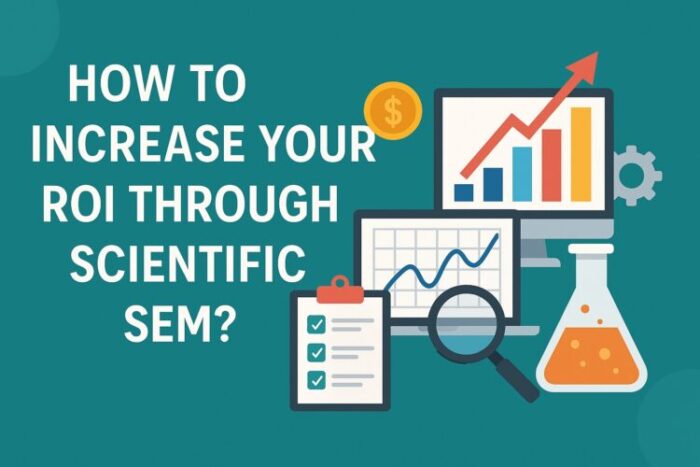Search Engine Marketing (SEM) has evolved, and it’s about getting smarter, more strategic, and yes, more scientific. Competition is rising and attention spans are shrinking; therefore, simply running Google Ads without a data-backed strategy is a fast way to burn your budget.
To increase ROI with SEM, top-performing businesses use a scientific approach grounded in testing, optimization, and analytics called Scientific SEM.
Scientific SEM means applying data analysis, experimentation, and continuous optimization to improve paid search performance. Instead of relying on guesswork, it involves:
- Setting clear KPIs (Cost-per-Click, Conversion Rate, ROAS)
- A/B testing ad creatives, headlines, and CTAs
- Using machine learning insights for smart bidding
- Refining keywords and targeting with behavioral data
This approach transforms SEM into a predictable, measurable growth engine.
Scientific approach includes the following steps.
The first step is defining your goals. Set clear, trackable goals.
Are you optimizing for:
- Sales?
- Leads?
- Brand awareness?
Each goal requires a different strategy and bidding model. Use tools like Google Ads Conversion Tracking and Google Analytics 4 (GA4) to monitor performance.
Set up conversion goals tied directly to revenue actions such as purchases, bookings, or form submissions.
The second step is to know that not all keywords are created equal. A scientific approach means identifying high-intent keywords that are more likely to convert, not just drive traffic. Use laser-focused keyword targeting
The following tools are useful for keyword research:
- SEMrush or Ahrefs for keyword discovery
- Google Keyword Planner for CPC insights
- Negative keyword lists to prevent wasted spend
Group keywords by funnel stage and intent, e.g., “buy CRM software” (bottom-funnel) vs. “what is a CRM” (top-funnel).
The third step is to test every element of your SEM campaign including:
- Ad headlines
- Descriptions
- CTAs
- Landing pages
- Bidding strategies
Create multiple ad variations and rotate them evenly. Leverage the data to know what performs best.
The tip here is that even small changes like swapping “Free Demo” for “Start Today” can significantly boost CTR and conversion rates.
The next step is to use smart bidding and audience targeting. You can leverage Google’s AI-powered Smart Bidding options like:
- Target ROAS
- Maximize Conversions
- Enhanced CPC
You can combine this with Audience Segmentation to show ads to users who’ve previously interacted with your site (retargeting) or those similar to high-converting customers (similar audiences).
Know that Scientific SEM is, Data + Automation + Precision
Next, you have to optimize landing pages for conversion. It is not enough to send traffic to a landing page because sending traffic to a poor landing page is like pouring water into a leaky bucket.
You should apply Conversion Rate Optimization (CRO) best practices which includes:
- Fast loading speed (under 3 seconds)
- Clear, benefit-driven headlines
- Minimal distractions
- Strong, visible CTA buttons
- Trust signals (testimonials, badges)
Tools like Hotjar or Microsoft Clarity can be used to study user behavior and make informed tweaks.
The next step is to monitor, measure, and iterate. No scientific approach is complete without iteration. You should continuously monitor key SEM metrics:
- Click-Through Rate (CTR)
- Quality Score
- Cost per Acquisition (CPA)
- Return on Ad Spend (ROAS)
Set up custom dashboards in Google Looker Studio for real-time performance insights. Pause underperforming ads, reallocate budgets, and keep testing.
In conclusion, boosting your ROI through SEM does not mean spending more; it’s about getting scientific. With the right tools, tracking, and optimization process, you can make every dollar work harder and smarter.
Whether you're a digital marketing manager or a small business owner, scientific SEM gives you a competitive edge in today’s fast-moving, algorithm-driven world.
